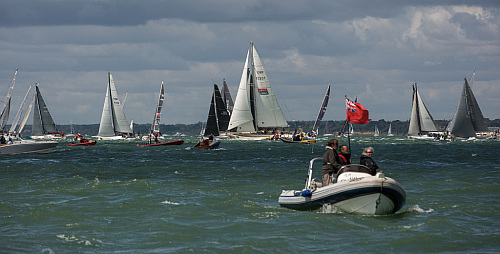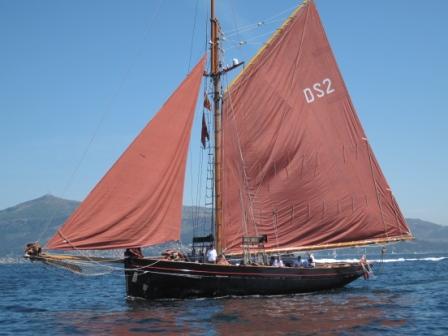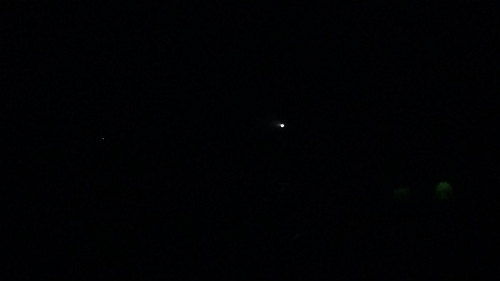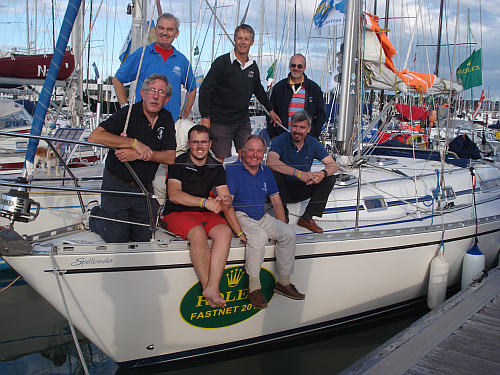One of the three classic offshore races, for many sailors the Fastnet is still regarded as Everest... PM Edward Sankey navigates...
It is one of the three classic offshore yacht races – Cowes out to the Fastnet Rock off South West Ireland and back to Plymouth. In straight line courses it is 608 miles, but sailing boats are rarely able to do the direct lines!
At its instigation it was a 4 to 5 day event of non-stop sailing, and for our boat it was all of that and more! Although sailing boat design and materials have evolved immeasurably, our yacht was a lot smaller than those first ones.
The start on Sunday morning made for an awesome sight – 360 yachts or so, all milling behind the start line off Cowes. Crew looked out in all directions to spot any yacht likely to approach too close for comfort. I’ve no idea how the skipper, on the helm, kept his cool.
Then a cavalry charge to the Narrows at Hurst Point and the Needles. Everyone on the windward rail to get the best speed and wondering what the next days had in store.

The Start Line: Crew looking out in all directions to spot any yacht likely to approach
too close for comfort....
We whooshed out of the Needles with the tide behind us all increasing our speed by 50-70% at its best! All eyes open again in this bottleneck. About 400 yards away we saw two yachts had run onto the Shingles bank and collided in their difficulty. The bank rises very steeply on the west side of the Narrows to make the water very shallow. In their enthusiasm had one boat been too aggressive in enforcing its right of way and driven them both on? No time to think about it – we had a decision to make. Portland Bill beckoned.
This classic started in 1925. Entered by seven vessels, the inaugural Fastnet Race was won by Jolie Brise. It is run every second year, a factor that makes it all the more special if one gets the chance. J
Jolie Brise is still frequently seen along the South Coast, owned by Dauntsey's School, founded in 1542 in accordance with the will of a Master of a Livery Company, the Mercers!

Jolie Brise : Winner of the inaugural Fastnet race in 1925
Although some new races are very much longer than the three classics, for many sailors the Fastnet is still regarded as Everest. Firstly, taking place in August, the race often has Westerlies that are strong to gale force in strength. The succession of low pressure systems from the North Atlantic provide a constantly moving weather pattern. These depressions mostly travel north of the English Channel. Knowledge of how best to use them is the key.
A second reason is that the tides run quite strongly back and forth along the South Coast , which can make for slow progress when they are against you, and very unpleasant condition when the tide is against the wind as it almost certainly will be a number of times.
Thirdly the Race is there and back, so you are almost certain to have to do every type of sailing – beating, reaching and running - so sailing skills are all tested.
Portland Bill’s tidal gate was the next focus. The Bill stretches southwards enough that we all have to go round it. But the tides can run very strongly there on the flood and the ebb, and if you are there at the right time it’s a huge boost to a sailing boat. For us, was impossible to get there when the tide was running with us, so we struck south to get well offshore into lighter tides. Fortunately from the point of view of wind directions over the next 48 hours, that was a good point of sail.
After a lively night with Force 4/5 wind from the West over a contrary tide past the Lizard, by Tuesday late afternoon we were off Lands End and we took a last look at the weather forecast apps before we went beyond mobile range into the Celtic Sea. Wednesday morning dawned a little calmer.
At the last minute I decided to use the Race as a fundraiser. I put up a page to seek donations for Epilepsy Research UK * and got a few emails off to people. The thought that people might be donating to this important cause kept me warm in the small hours!
The long stretch across the Celtic Sea gave us our toughest conditions. The wind grew to force 6 (up to 30mph) on our port bow and the waves built to 3 metres, and grew sharper as the tide turned against us. The pounding slowed us down. We had this all day until it started to ease a little over Wednesday night as we headed just north of west.
When did we go around the Rock? 11.45pm! Darkest part of the night, though a full moon gave us a wonderful ghostly vision of the Rock, and a great silhouette as we went round the other side. Then by dawn the wind died! Madly frustrating and we tried everything to get the best speed.

11:45 pm: View of the Rock from the Fastnet deck....
Something unusual the following night. In the early hours we heard a couple of the larger yachts in the Tall Ships fleet talking about us. They had been reached by the Race Office via satellite link (most of the fleet had only VHF radio and we were out of range for that.) All yachts carry an AIS device which enables their locations to be known to other vessels and the Race Office. Our trace had gone, shortly after we were at the Rock. We were in the same part of the fleet as the Tall Ships – could they ask yachts within VHF range if anyone had had a contact from us?
Of course we jumped in and told them we were fine, and one of them relayed it back to the Race Office, so the potential alarm was forestalled. A couple of us set about to find out what had happened. Eventually normal service was restored before family and friends had their first look at the AIS of the morning…..
The Fastnet Race has always been known for the likelihood of challenging conditions at some stage. However the 1979 Race grabbed the attention worldwide of sailors and non-sailors alike – for all the wrong reasons.
A severe storm resulted in the deaths of eighteen people (including three rescuers) and the involvement of some 4,000 others in what became the largest ever rescue operation in peace-time. Five boats sank, and at least 75 boats flipped upside down. Out of tragedy came many good things though, about safety, equipment, preparation for the race. The fact that so many boats were in the same area of the Celtic Sea, logging barometric readings, led to a great improvement in the understanding and modelling of storms: in particular that very intense micro-storms can briefly form within the large storm system. Meteorologists changed their approach to forecasting.
The Race drew further attention from outside the sport in 1985 when the maxi yacht Drum capsized after the keel sheared off. This wouldn’t normally have been noteworthy outside the sailing world but on board was Simon Le Bon from Duran Duran, co-owner and crew member. He and five other crew members were trapped under the hull for twenty minutes, until rescued by Royal Navy helicopter.

The Fastnet crew of seven: PM Edward Sankey at top left
We were a crew of seven, two watches of three and a skipper/navigator/galley slave! We call our skipper Iron Man because of his ability to function with just catnaps, and able to produce meals and wash up in the worst of conditions! We knew each other well, not least because of the qualifying races. We always had plenty to talk about in the three hour watches.
On Friday morning we were approaching the Scillies once more and the wind was building again from the West, with a following sea. Spinnaker up, and all was good! It built further and we eventually had to drop the spinnie. We made our way east, past a dozen or more big ships at anchor off the Lizard awaiting their next orders, and across the bay to Plymouth. That passage, in the dark, seemed to take forever, as we all sought out the high marker lights showing the harbour entrance. The wind eased and when we saw the lights, our willing the boat on towards them was almost tangible!
Across the finishing line – relief, cheers, handshakes and hugs all round! Into the Marina and tied up at 2.30am Saturday. Five and three quarter days! A drink in the Race tent, a drink or two back on board, pride in having beaten a number of our rivals, and for myself three hours sleep before heading for the train. Never has a British railway carriage felt so comfortable!
- The Epilepsy Research UK donation page is still open if anyone wants to make a donation to this important cause – see http://uk.virginmoneygiving.com/EdwardSankey1 Anything would be greatly appreciated.

Past Master Edward Sankey